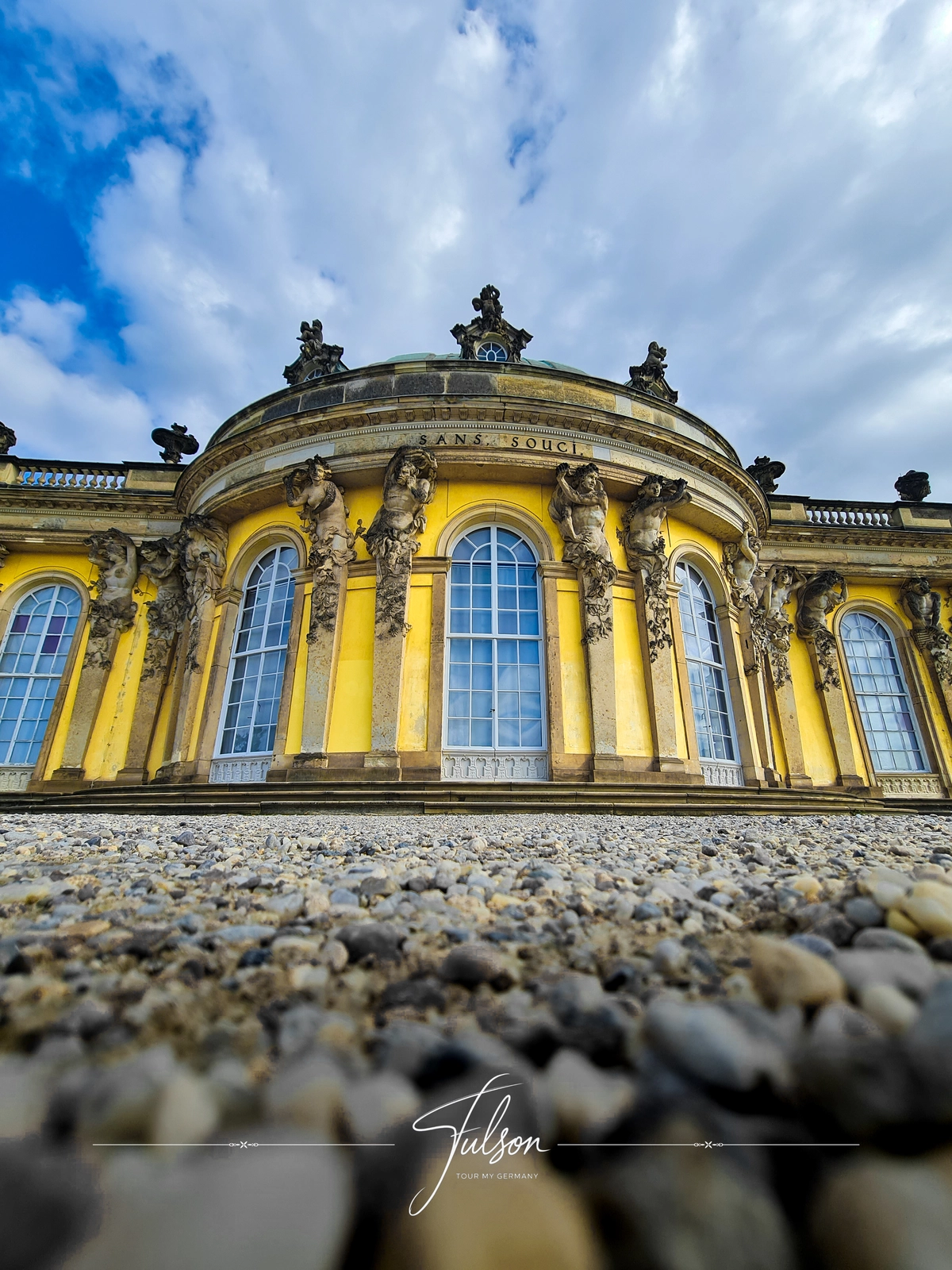- Home
- Top German Cities To Visit
- Berlin Photo Gallery
- Sanssouci Palace
Sanssouci Palace, Potsdam: A Must-See Berlin Day Trip
By: Eran Fulson / Traveler & Blogger / After 15+ years of travel across North America and Europe, I now help travelers experience Germany beyond the guidebooks with firsthand tips and cultural insights.
About the Photo
This striking shot captures the intricate Rococo architecture of Sanssouci Palace, bathed in golden hues under a dramatic sky. I'm always one for taking photos from a low-angle perspective. From down here, the ornate details of the facade, featuring sculpted columns and Baroque-style windows, just feel even more dramatic.
The name Sans Souci—French for "without worries"—is proudly displayed above, reflecting Frederick the Great’s vision of this summer retreat as a place of relaxation, music, and philosophy.
Located just an hour from Berlin, Sanssouci is one of the best day trips for those seeking a mix of history, nature, and elegance. Strolling through its extensive vineyards and terraced gardens feels like stepping into a painting—a true hidden gem beyond the bustling German capital.
Did You Know?
- Frederick the Great was so fond of this palace that he requested to be buried here, alongside his beloved Italian greyhounds. His wish was granted in 1991, more than 200 years after his death!
- Unlike Versailles, which was built for grandeur and political affairs, Sanssouci was meant as an intimate retreat—no lavish court life, just music, art, and deep conversations.
- The palace gardens are home to over 3,000 fruit trees, including figs, peaches, and melons—Frederick had a taste for Mediterranean flavors!
How to Visit Sanssouci Palace from Berlin
- By Train: Take the RE1 regional train from Berlin Hauptbahnhof to Potsdam Hauptbahnhof (approx. 25 minutes), then hop on a bus or walk 25 minutes to the palace.
- Opening Hours: Typically open Tuesday–Sunday (closed Mondays), but always check the official website before visiting.
- Tickets: A combined palace and garden ticket is recommended for the best experience.
Want More Unique Places Near Berlin?
You couldn't do much better than stopping by the sprawling German capital. Happily, there is little that Berlin doesn't provide in its eclectic bag of cultural offerings.
Whether it's numerous displays of iconic architecture, dozens of museums, or an embracing alternative scene, they all make up a city with a unique and appealing atmosphere.
One doesn't have to travel far in any direction to see poignant memorials to a troubled history. While respectful homage is duly paid, there is no denying the cosmopolitan feel that Berlin has embraced over recent years. It's an easy city to get to, but a difficult one to leave.
How do I get to Sanssouci Palace from Berlin?
How do I get to Sanssouci Palace from Berlin?
The easiest way to reach Sanssouci Palace from Berlin is by train. Take the RE1 regional train from Berlin Hauptbahnhof to Potsdam Hauptbahnhof (about 25 minutes). From there, you can either:
- Walk (about 25 minutes)
- Take Bus 695 to "Schloss Sanssouci" (approx. 10 minutes)
If you prefer a scenic route, walking through Potsdam’s historic city center and parks is a great option!
Do you need tickets to visit Sanssouci Palace?
Do you need tickets to visit Sanssouci Palace?
Yes, but it depends on what you want to see.
- Sanssouci Park (gardens & exterior) is free to visit.
- The palace interior requires a ticket, usually around €12–€14 for adults.
- A “Sanssouci+ Ticket” (€22) includes access to all of Potsdam’s palaces, which is great for a full day of exploring.
Pro Tip: Tickets sell out fast in peak season, so it’s best to book in advance online.
What makes Sanssouci Palace unique compared to other castles in Germany?
What makes Sanssouci Palace unique compared to other castles in Germany?
Unlike grand German castles like Neuschwanstein or Heidelberg Castle, Sanssouci was built as a personal retreat rather than a fortress or political center.
Key differences:
- Rococo-style architecture—Light, elegant, and intimate (not a massive Gothic structure).
- Garden paradise—The vineyard terraces and massive parks make it feel more like a retreat than a castle.
- Philosopher’s getaway—Frederick the Great hosted thinkers like Voltaire, making it a hub for Enlightenment ideas.
It’s often called "Prussia’s Versailles"—smaller, but packed with charm and history!

